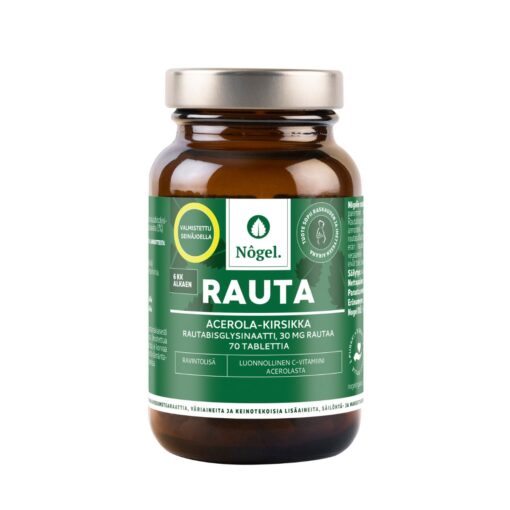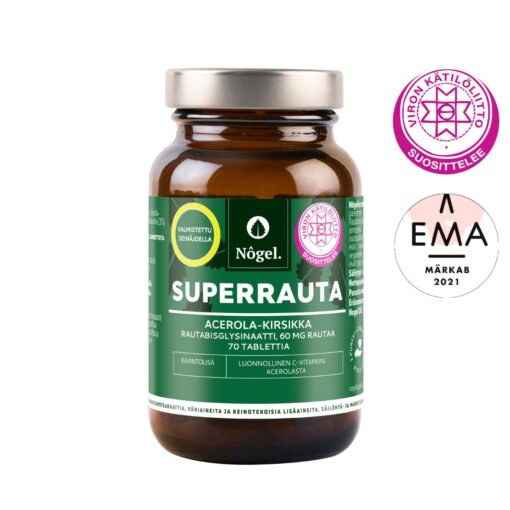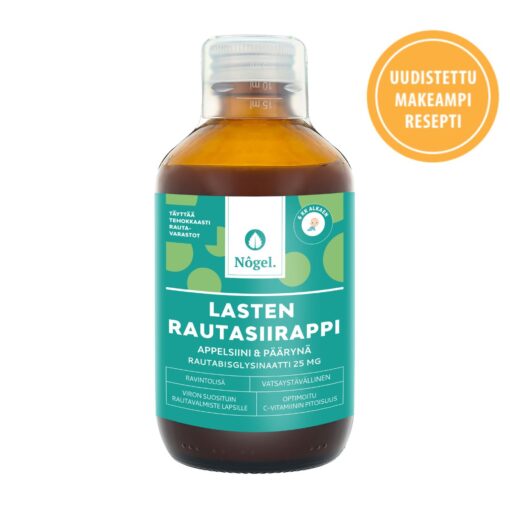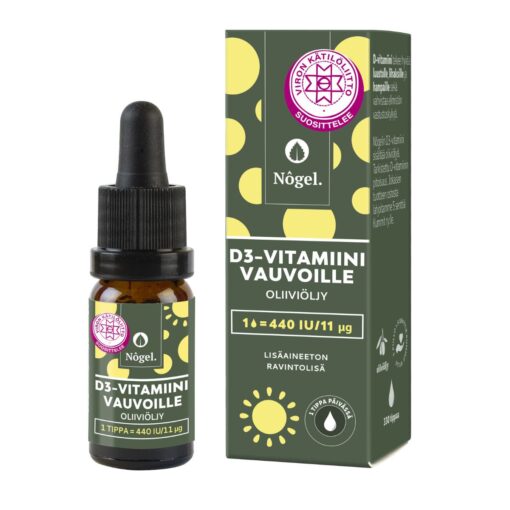Yes, Nôgel’s iron food supplements are suitable for pregnant women. Iron bisglycinate has high bioavailability (good absorption) and does not usually cause gastrointestinal side effects. Because constipation during pregnancy is a problem for many women due to slower metabolism, it is good to choose iron in bisglycinate form when picking an iron food supplement. Like other iron salts, a lot of research has been done about using iron bisglycinate during pregnancy and in infants, and iron bisglycinate has been used in food supplements for a long time already. Iron bisglycinate has been approved by the European Commission for use in baby food.
Yes, Nôgel’s iron food supplements are suitable for adults and children from age 12. It is easier to give iron in syrup form to very small children, but also Iron 30 mg is suitable when crushed. It all depends on the child´s iron stores and the physician´s recommendation in case of iron deficiency anemia.
Nettle and nettle extract can be found in several iron food supplements, so nettle is already a well-known ingredient in iron food supplements. Nettle contains vitamin K. Vitamin K can also be found in parsley and other herbs, also in sauerkraut, Brussels sprouts, spinach, wheat germ, cauliflower, soy flour, broccoli, rapeseed oil, rosehip berries, cabbage, wheat bran, potatoes, oats, corn, peas and beans. So vitamin K can be found in many different foods. However, eating vitamin K regularly in large amounts can cause blood clotting. However, natural vitamin K is not related to toxic amounts and quickly exits the body. Our iron food supplements have been tested in the laboratory for vitamin K. In order to get 100% of the daily recommended dose of vitamin K (in Estonia it is 75 micrograms) from Nôgel´s iron food supplements 30/60 mg, you would have to eat about 37/107 pills and even then it is only 100% of the daily recommended dose, not a dangerous amount. One pill contains only 2/0.67 micrograms of vitamin K, which is 2.7/0.9% of the daily recommended dose. Iron syrup for children contains less than 0.7 mcg of vitamin K per 10 ml, i.e. less than 0.9% RDA. Read more about vitamin K from HERE.
It is recommended to take 5-10 g of chlorella daily for an effective detox. Nôgel’s iron food supplements contain only very small amount of chlorella. In Asia, it is recommended to use chlorella to prevent iron deficiency anemia during pregnancy. It has also been found that breastfeeding women, who regularly use chlorella, have less dioxins in their breast milk. These are only some examples. There’s no need to be afraid of the little chlorella in the supplements.
No, Nôgel’s iron food supplements have been tested in the laboratory and do not contain iodine.
No, carnauba wax comes only from the leaves of a palm tree Copernicia prunifera wild harvested in Brazil. Palm oil comes from the pulp of oil palms and it is due to new oil palm plantations that large areas of rain forest are being cut down. Palms producing carnauba wax grow only in Brazil and to get the wax, leaves are shaken, trees are not cut down. These are two different trees.
The recommended daily allowance in Finland for adults is 9-15 mg and 8-15 mg for children, depending on their age. Ferritin levels describe the body’s level of iron stores the best – low ferritin levels are always a sign of iron deficiency. There can be different reference values for ferritin between different laboratories but a result of <12 μg/L almost always indicates iron deficiency. Latent iron deficiency can be diagnosed with a result of <20-30 μg/L.
It is recommended to check your body´s iron stores – ferritin level and hemogram before using iron food supplements. Iron supplementation is often not needed based on just ferritin value. Analysis of hemogram and possible iron deficiency related symptoms are an important part of the final diagnosis.
Now there is also a new way for diagnosing iron deficiency and that is checking for transferrin soluble receptors. Unlike ferritin, transferrin soluble receptors are not influenced by related illnesses. Increased amount of transferrin soluble receptors indicates iron deficiency. Too much iron can be harmful, so iron food supplements should not be used as a preventive measure. For a healthy person, excess iron is not absorbed. In case of an existing iron deficiency anemia, it is often not enough to consume 30 mg a day and it is usually necessary to take iron in bisglycinate form 60-120 mg a day. Depending on the person, hemoglobin levels usually normalize in 6-8 weeks. For filling up iron stores, it is recommended to take iron supplements for an additional 3-4 month period. In case of latent iron deficiency (blood test is still normal, but body´s iron stores are low), it is enough to consume 30-40 mg of iron a day in iron bisglycinate form for 3-4 months. In case of very low ferritin levels, iron treatment usually lasts from 6-12 months.
Until now it has been suggested taking iron supplements twice a day at different times rather than taking once a day in single dosages. Newer research has found that iron absorption is optimized when taking iron every other day in single dosage. Taking iron every other day is recommended to people, who suffer from chronic inflammatory diseases.
It is advised to start with 30 mg of iron a day and increase the daily intake in a couple of weeks’ time to let the body get used to iron. Before using iron food supplements, consult with a physician or a midwife. It is recommended to use iron food supplements only if necessary. If you have used iron food supplements before in the form of iron sulphate, citrate, fumarate or gluconate and your daily intake has been 100-300 mg, it is recommended to take 60-120 mg of Nôgel´s iron food supplement a day, i.e. about half the amount. There is no point in getting a new blood test done before 6-8 weeks’ time because filling up iron stores takes time. Giving blood on a regular basis also decreases the body´s iron stores. In case you have any questions related to Nôgel´s supplements, feel free to send an e-mail to hello@nogelorganics.fi
3-6 mg/kg, i.e. a 10 kg child should get 30-60 mg dosage of elemental iron in bisglycinate form. Start with 3 mg/kg. In a randomized trial, iron(III)polymaltose complex and iron bisglycinate were compared on children aged 1-13 years. Both iron salts were given 3 mg/kg. Outcome: Both iron salts raised blood hemoglobin levels, but polymaltose complex did not significantly increase ferritin level. Iron bisglycinate increased significantly ferritin and MCH levels.
It was also found that iron bisglycinate acts in the same way as natural iron from food, i.e. absorption of iron decreases when iron stores are getting fulled. The absorption of iron with iron bisglycinate is negatively correlated with the rise in ferritin and hemoglobin levels.
Source: Name JJ, Vasconcelos AR, Valzachi Rocha Maluf MC. Iron Bisglycinate Chelate and Polymaltose Iron for the Treatment of Iron Deficiency Anemia: A Pilot Randomized Trial. Curr Pediatr Rev. 2018;14(4):261-268. doi:10.2174/1573396314666181002170040
Absorption of iron bisglycinate is high, studies have shown bioavailability to be around 90%. For example, the bioavailability of iron sulphate and fumarate is around 26–28%. Scientific studies have found that iron in bisglycinate form absorbs 2-4 times better than iron sulphate and fumarate. Iron bisglycinate is also less irritable to the stomach – it does not usually cause gastrointestinal side effects like constipation, abdominal pain and nausea. Read more about iron bisglycinate and other iron salts HERE.
The higher the bioavailability, the more iron is absorbed by the body. It is important to compare the iron salt used and product´s elemental iron content when choosing iron food supplements. For instance, Nôgel Superraud 60 mg (elemental iron content), iron bisglycinate (name of iron salt).
Example 1:
Iron sulphate pill of 100 mg of elemental iron
Bioavailable iron app. 26% i.e. 26 mg
In case of iron deficiency, body increases non-heme iron absorption up to 20%, absorption of elemental iron is therefore 26 mg*0,2 = 5 mg.
Example 2:
Nôgel Superraud, iron bisglycinate pill of 60 mg of elemental iron
Bioavailable iron app 90% i.e. 54 mg
54 mg*0,2 = approximate absorption of iron is therefore 11 mg.
Iron food supplements containing heme iron contain usually either food albumin (e.g. hematogen) or hemoglobin (pill/capsule form supplements). In Estonia, hematogen bars usually contain 10 mg of heme iron for 100 g. From one bar you will get around 5 mg of heme iron (50 g bar). Nowadays hematogen bars contain a lot of sugar – usually at least 50% of the bar is made up from sugar as condensed milk and white sugar. Such bars are not suitable for diabetics.
In case of supplements containing hemoglobin, it is necessary to take into account the actual content of hemoglobin. 1 g of hemoglobin contains around 3,5 mg of heme iron, i.e. 500 mg of hemoglobin contains only 1,75 mg of heme iron, which is a rather low iron content. In case of diagnosed iron deficiency, such low heme-iron content is not sufficient. Although body absorbs heme-iron better than non-heme iron (15–35% vs 1–20% based on nutrition sciences), vitamin C increases non-heme iron absorption manyfold, when consumed 20–60 mg at the same time with iron. Higher vitamin C content increases the amount of free iron and causes more oxidative stress, which we discussed here.
NB! For instance, in Estonia food supplement producer is not obliged to bring out the content of heme and non-heme iron. Check the content of hemoglobin! Usually food supplements containing hemoglobin also contain some non-heme iron (e.g. divalent iron sulphate, which has low bioavailability and often irritates the stomach). The elemental iron content on the label is the sum of all elemental iron in the product (heme+non-heme iron).
Nôgel’s iron food supplements should be consumed with liquid (i.e. water, lemon juice, orange juice) and preferably on an empty stomach to increase absorption. Children´s iron syrup can be used directly preferably on an empty stomach. For very small babies and toddlers, syrup can be mixed with food (not to consume calcium at the same time).
Until now the suggestion has been to take iron supplements daily. However, new research has found that iron absorption is optimized, when iron is taken every other day in single doses. If you have been advised to take iron daily during a 3-month period, you can take iron every other day during a 6-month period. Taking iron every other day is especially suitable for people, who suffer from inflammatory intestinal diseases.
Iron treatment usually lasts for 6-12 months because ferritin, i.e. iron stores, increase slowly. In case of iron deficiency anemia, hemoglobin usually increases first. It is good to check iron related blood tests every 2-3 months during iron treatment.
The suggested minimum ferritin value for adults is 50 μg/l although some studies propose higher values (70-100 μg/l). Here you should take into account that unbound iron damages cells and you shouldn´t treat iron deficiency independently and therefore, try to achieve a certain ferritin value. In case of people with chronic diseases, iron deficiency anemia is excluded with ferritin values of >100 μg/l (ferritin is an acute phase protein, which value can increase independent of iron stores in case of infections, liver pathology and tumors).
The choice of iron supplement depends on a person´s iron stores (ferritin level) and whether iron deficiency anemia has already developed.
Superraud (Superiron, 60 mg pill) is suitable for persons with diagnosed iron deficiency anemia or iron deficiency without anemia (low ferritin level and changes in hemogram). Superraud is usually used during pregnancy.
Raud 30 mg (Iron, 30 mg pill) is suitable for persons with diagnosed iron deficiency without anemia (ferritin <30 μg/l and changes in hemogram). In that case it is also suitable to use Superraud, but 30 mg of iron in bisglycinate form is also effective in increasing iron stores. Raud 30 mg is also suitable during pregnancy but usually Superraud is used due to high iron need during pregnancy. Product is also suitable for babies from 6-months old (pill crushed) and for women with heavy menstruation (iron can be taken during menstruation to maintain a healthy ferritin level, consult first with a gynecologist).
Laste rauasiirup (Iron syrup for children) is suitable for babies from 6-months old (diagnosed iron deficiency (anemia)). Iron syrup has the same recommendations like Raud 30 mg (in case a person prefers to take iron in syrup form).
Doctors usually check clinical blood panel and ferritin level. This is often not enough. In addition soluble transferrin receptor (sTfR) should be checked (higher value refers to iron deficiency) and it is also good to check inflammation indicator (CRP). Ferritin is an acute phase protein and its value can increase in case of infections, liver pathologies and tumors. Soluble transferrin receptor test is not influenced by acute phase response and enable to distinguish between iron deficiency anemia and anemia due to some chronic disease.
The reference values for ferritin, i.e. iron stores, are wide and values depend on a child´s age. Ferritin´s laboratory reference values have been unchanged for decades and do not take into account recent studies about diagnosing iron deficiency (anemia).
Research carried out in 2018 investigated children´s hematological parameters of different age groups combining 11 years of pediatric iron study and hematology results for analyzing functional lower reference value for ferritin. Functional lower reference values of ferritin were analyzed in terms of limit, where ferritin threshold was reached and hematological parameters continued to be stable. Current research proposes that functional lower reference values for ferritin should be the following:
4-months– 13-years children 26 μg/l
13-years– 19-years (incl.) 39 μg/l
These ferritin values should be used for diagnosing iron deficiency without anemia, when hemoglobin levels are still within the reference range, value of hematocrit has decreased, red blood indices (MCV, MCH, MCHC) have decreased in value and number of red cells is normal or has decreased. Following changes may appear in iron related values: low transferrin saturation, increased iron binding capacity, increased transferrin soluble receptors concentration in serum. In case current lower reference values are used, symptomatic iron deficient children (with no anemia) may be ignored.
Just like adults every children is unique and there is no need to start using iron supplements based on just ferritin value – analysis of hemogram and symptoms are an important part of iron deficiency (anemia) diagnosis.
Vitamin B12 in our blood is bound to two different transport proteins: haptocorrin and transcobalamin. Only 10-30% of vitamin B12 is bound to transcobalamin, which is also known as the active form of B12. The blood level of the active form declines in case of vitamin B12 deficiency already before symptoms occur. Vitamin B12 active form, i.e. transcobalamin test, is the primary analysis for testing for vitamin B12 deficiency and effectiveness of treatment.
Ordinary vitamin B12 test is a much cheaper analysis, but it is not the primary analysis for testing for vitamin B12 deficiency and effectiveness of treatment. This test is normally used for instance to diagnose megaloblastic anemia (abnormally large red blood cells). Ordinary vitamin B12 test covers the total content of B12 – active and inactive form. Results below the reference value normally clearly indicate vitamin B12 deficiency. Results close to the lower limit of reference value, in case of adults <250 pmol/L, are often so-called gray area and difficult to interpret. Thus, it is necessary to perform active form, holotranscobalamin test.
- vitamin B12 supplement should not be used before the analysis
- analysis should be taken as fasting blood sample
- analysis cannot be performed in case during last 8 hours, large amounts of biotin have been used (>5 mg/day)
Taking vitamin B12 supplement before the analysis may increase the content of vitamin B12 and therefore, interpretation of results is more difficult. Oral contraceptives and antibiotics may to some extent lower vitamin B12 level.
You can find all ingredients of iron food supplements from IRON SUPPLEMENTS and ingredients of vitamin D3-drops from OTHER SUPPLEMENTS.




